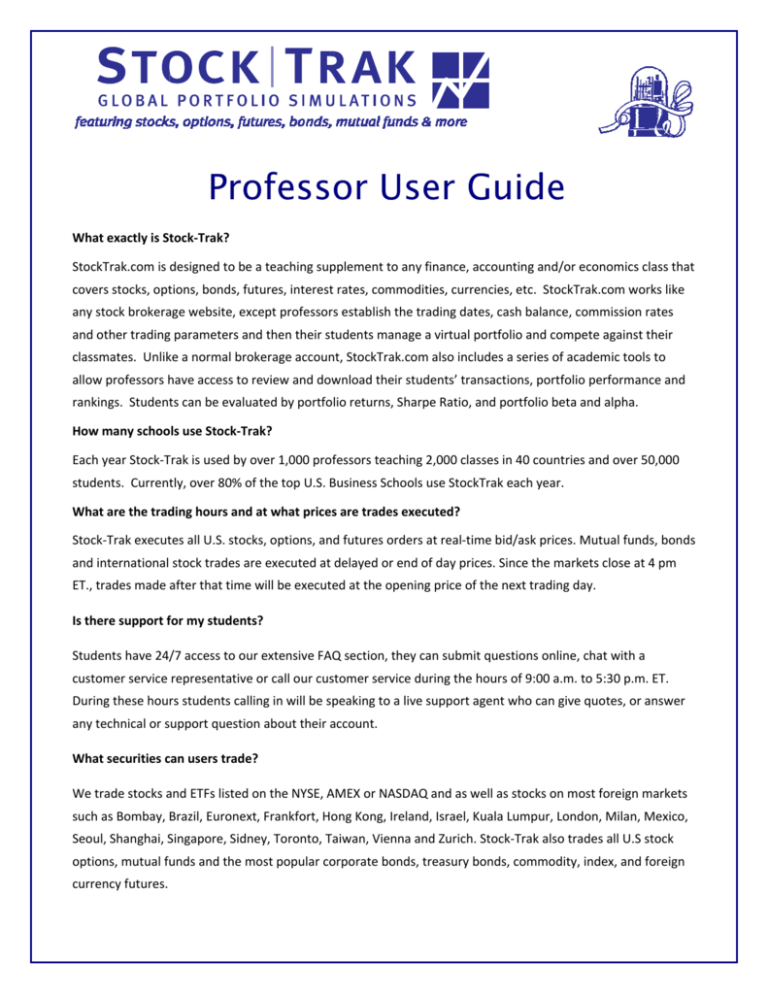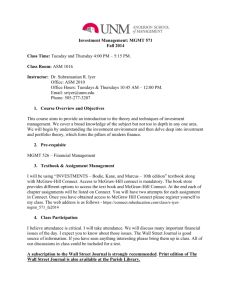Professor User Guide - Stock-Trak
advertisement

Professor User Guide What exactly is Stock‐Trak? StockTrak.com is designed to be a teaching supplement to any finance, accounting and/or economics class that covers stocks, options, bonds, futures, interest rates, commodities, currencies, etc. StockTrak.com works like any stock brokerage website, except professors establish the trading dates, cash balance, commission rates and other trading parameters and then their students manage a virtual portfolio and compete against their classmates. Unlike a normal brokerage account, StockTrak.com also includes a series of academic tools to allow professors have access to review and download their students’ transactions, portfolio performance and rankings. Students can be evaluated by portfolio returns, Sharpe Ratio, and portfolio beta and alpha. How many schools use Stock‐Trak? Each year Stock‐Trak is used by over 1,000 professors teaching 2,000 classes in 40 countries and over 50,000 students. Currently, over 80% of the top U.S. Business Schools use StockTrak each year. What are the trading hours and at what prices are trades executed? Stock‐Trak executes all U.S. stocks, options, and futures orders at real‐time bid/ask prices. Mutual funds, bonds and international stock trades are executed at delayed or end of day prices. Since the markets close at 4 pm ET., trades made after that time will be executed at the opening price of the next trading day. Is there support for my students? Students have 24/7 access to our extensive FAQ section, they can submit questions online, chat with a customer service representative or call our customer service during the hours of 9:00 a.m. to 5:30 p.m. ET. During these hours students calling in will be speaking to a live support agent who can give quotes, or answer any technical or support question about their account. What securities can users trade? We trade stocks and ETFs listed on the NYSE, AMEX or NASDAQ and as well as stocks on most foreign markets such as Bombay, Brazil, Euronext, Frankfort, Hong Kong, Ireland, Israel, Kuala Lumpur, London, Milan, Mexico, Seoul, Shanghai, Singapore, Sidney, Toronto, Taiwan, Vienna and Zurich. Stock‐Trak also trades all U.S stock options, mutual funds and the most popular corporate bonds, treasury bonds, commodity, index, and foreign currency futures. Class registrations and class accounts questions: How Do I Register My Class? Registration is easy. As a professor, you simply register on StockTrak.com by clicking on the “Professor” button on the home page, then under the ADMIN menu select “Register Class.” You will be asked to fill out a form with the class name, and different parameters such as type of service, initial cash, position limit, and allowed securities to trade. Once you complete the registration you will receive an HTML link that you then distribute to your students. What is the cost for the student accounts? The cost per account depends on the length of the trading period. Most professors select a 10 week trading period for $26.95. Keep in mind that 2 students can share an account, and most finance textbooks have coupons in them for $5‐$8 off to help keep the price affordable for all students. How long does the trading period last? The length of the trading period is up to you. We recommend that the trading period begin one or two weeks after your class has started, and that it ends at least one week before your last class. This will give your students some time to write a summary of their portfolio strategy and analysis of their return. When does the trading period begin? You select the trading period. We just recommend that the trading period begin on a Monday and end on a Friday since most reporting that StockTrak provides is on a weekly basis. Are any commissions charged on Student's Transactions? The commission structure is set by the professor. You can choose a flat fee per trade or a percentage of the trade amount. What is the initial cash balance for the students? You have the flexibility to choose whatever portfolio size and currency ($, CD$, €, £, ¥, etc.) you want your students to have. We recommend $100,000 for undergraduates and $1,000,000 for graduate students. How can a professor view their students’ progress? When you log in to your professor account, you can view your class by clicking on the ADMIN tab and then on view class. There you will be able to see the students’ rankings and other details such as their portfolio value and account records. You can also export these details to excel by clicking on the excel button. Do the Professors get a free account? Yes, when you register and create a class on StockTrak.com, you will be given 2 free accounts that can by used by yourself, your assistant, or use them to show your students how to make a trade. How Do I Prevent My Students From Taking Very Risky Positions? Give the students a disincentive for losing money or underperforming the S&P500. For example, some professors tell their class that the top 3 performing students will get 5 extra credit points on their final exam grade, and the 3 worst students will get 5 points taken off their final exam grade (the professors then give the bonus points but do NOT take off points from the poor performers‐‐just the threat is enough to make the students stay more conservative). Other professors tell their students to ignore the percentage return rankings and focus on the Sharpe‐Ratio or the portfolio alpha rankings. The students will have a challenge trying to place in the top 3 of their class on these risk‐adjusted measures. Also, remember that you have a good deal of flexibility when it comes to specifying the simulation you want for your class. You can limit the number of transactions, size of trades, or type of security. We will work with you to make sure that your students get the most out of Stock‐Trak. To force students to diversify their portfolios, and to make the students trade as if it was real money, students will not be able to put "all their eggs in one basket." Stock, option, and future positions will be limited to 25% of their initial cash balance. Accounts that begin with $100,000 will only be allowed to spend $25.000 on any given stock. (Without this position limit, we have seen some students buying on margin and spending $200,000 on one stock; now they can only spend 1/4 of that on any stock, option, or future.) How Can Stock‐Trak be incorporated Into My Class? Professors are finding that Stock‐Trak can play an integral role in the success of their class. Stock‐Trak allows you to blend classroom theory with real world experience, tailored to the level of your students. Stock‐Trak is most effective when it is used to complement your lectures. The first place to start is to look at your textbook. Go through each chapter and pull out specific types of trades that your book covers each week and have the students make similar trades in their StockTrak account and you might come up with a list of 15 to 20 specific trades like this: • Buy a low P/E stock and a high P/E stock in the same industry • Buy a high dividend yielding Stock • Buy a large cap and a small cap stock • Buy a high coupon treasury bond and a low coupon treasury bond • Buy a short‐term maturity corporate bond and a long‐term corporate bond • Buy an international ETF, a commodity ETF, and an industry ETF • Buy a stock from Europe, Asia, and Latin America • Short a stock • Use a limit order, a stop order, a trailing stop order • Hedge some of the stocks you purchased with put options • Write a covered call on one of your stocks • Trade an option straddle, bull spread, and calendar spread • Hedge your bonds with interest rate futures • Hedge your international exposure with currency futures • Hedge your commodity ETFs with commodity futures Other ideas: • One professor distributes a new scenario every two weeks and then grades the students on how they adjust their portfolio. Past scenarios have included dropping interest rates, high inflation, war breaking out in the Persian Gulf, or large gains in the leading indicators. • The infamous dart board has historically been a very effective tool for demonstrating portfolio theory and it can easily be combined with the Stock‐Trak experience. Professors who have used this approach typically paste a list of securities on the wall (the dart board) and then throw darts to select a portfolio. Using one of the two free accounts each professor receives, the dart board account can be tracked throughout the trading period. Students can compare their results to the "random" portfolio and see the principles of portfolio theory in action. As an incentive for the student to take an active interest in his or her portfolio, points can be given on the final for doing better than the dart board account or the S&P 500. Some professors even take a few points away for doing worse than the S&P. • The important thing to remember, however, is that the emphasis should be on education and not portfolio return. Stock‐Trak is a tool for exposing students to the stock market. You want the students to care about what they are doing, but don't make them so concerned about the return on their portfolios that they miss out on the educational experience. Our Pledge Is To Make Sure Your Students Receive The Best Portfolio Simulation Available.... Let Us Know If We Can Help Stock‐Trak Work Better For You And Your Class call us at 1‐514‐871‐2222 ext 232











